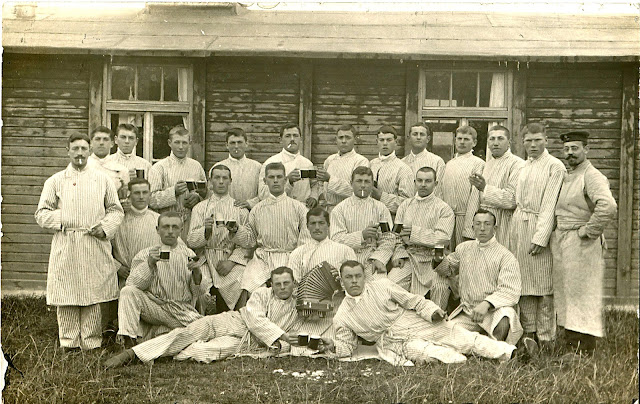Men in striped pajamas
share a beer, a smoke,
and an accordion.
share a beer, a smoke,
and an accordion.
Even more men dressed in loungewear
surround a military band
that's ready to play a concert.
surround a military band
that's ready to play a concert.
Both images are examples
of how the healing powers of music,
(and maybe lager and tobacco too),
were once used to restore
soldiers to good health.
of how the healing powers of music,
(and maybe lager and tobacco too),
were once used to restore
soldiers to good health.
The full photograph shows a group of 23 German soldiers enjoying a period of rest and recuperation outside their barracks at a lazaretto, a wartime military hospital. The term lazaretto comes from an Italian word applied to a quarantine station used for confining maritime travelers suspected of carrying contagious diseases.
The location comes from a stamp on the back of the postcard that reads ReserveLazaretti Weingarten (Württ.) with a postmark dated 29 November 1915. It was sent via the German military's free Feldpost, presumably from one of the men pictured on it, but the pencil handwriting is too difficult to decipher. Weingarten is a small town in Württemberg on the border of Switzerland, near the Bodensee or Lake Constance.
The war was now in it's second year and
Germany now had many lazaretti scattered across the country to care for
its wounded or sick servicemen. It's curious that none of the soldiers in this
photo appear injured or ill, so perhaps it was taken just before they
were to be released from hospital and return to their regiments.
The second photo was taken in the tiled courtyard of a large unidentified building that looks fairly institutional with its grand cut stone archways. A German army band of about 26 musicians sits with their instruments and music stands as if ready to perform. Surrounding them are over a hundred soldiers, many dressed in pajamas and the rest wearing enlisted rank uniforms. Everone has paused to look at the camera. Behind the band are about two dozen men standing on risers who might be a men's choir. But even if they weren't, though I don't see any evidence there was any beer consumed. I feel certain that there was singing at this concert.
Sadly there are no marks on the postcard to fix a place or time other than that they are definitely in German uniforms from the 1914-1918 era. According to the statistics found in the Wikipedia entry for World War I Casualties, the German military suffered 4,215,662 wounded servicemen between August 1914 and November 1918. This compares to 3,620,000 wounded sustained by the armed forces of the Austria-Hungary Empire; and 400,000 to 763,753 for the Ottoman Empire. The number of wounded for the allied powers were similar, 3,749,000 to 4,950,000 for the Russian Empire; 4,266,000 for France; 1,675,000 for Great Britain and its colonies (which did not include Canada, Australia, or New Zealand); and just 204,002 for the United States which did not enter the war until 1917. Taken all together, easily over 20 million men were wounded, maimed, or traumatized in some way by the war. And this is not even counting the deaths.
Considering the cacophonous noise of battle, not to mention the stressful effort of just staying alive, the opportunity to sing songs with your comrades or listen to a music concert must have felt like a soothing distraction to these soldiers. My only question is, did their pajamas have blue stripes or green, or maybe red? And were the hospital PJs for soldiers of other nations in a different color or pattern?
This is my contribution to Sepia Saturday
where everyone is feeling much better now.
where everyone is feeling much better now.







3 comments:
I immediately thought the mugs contained coffee...ha ha ha. Of course they wouldn't be just waking up in their pj's for a photo...and I agree, they did look rather hale and hearty...a beer with a smoke for some...sort of a welcome card for those coming to the hospital and those going home.
The number of men wounded in that war is really overwhelming! :o
These sepia images always leave us with questions, but not about the healing power of music.
Post a Comment